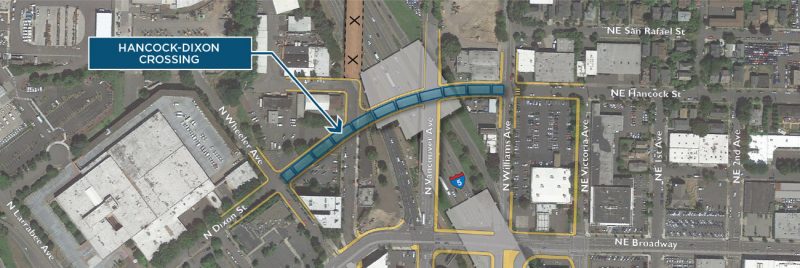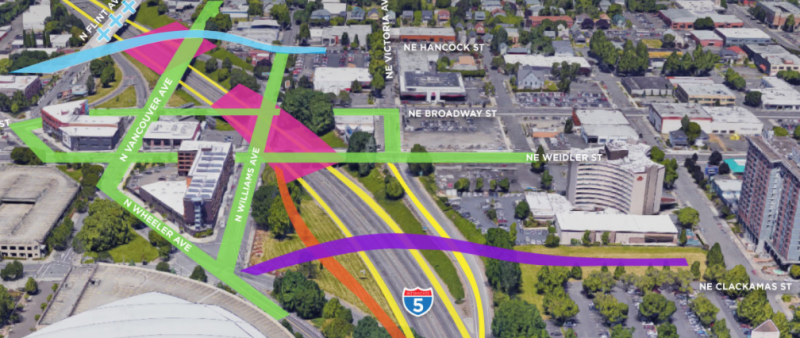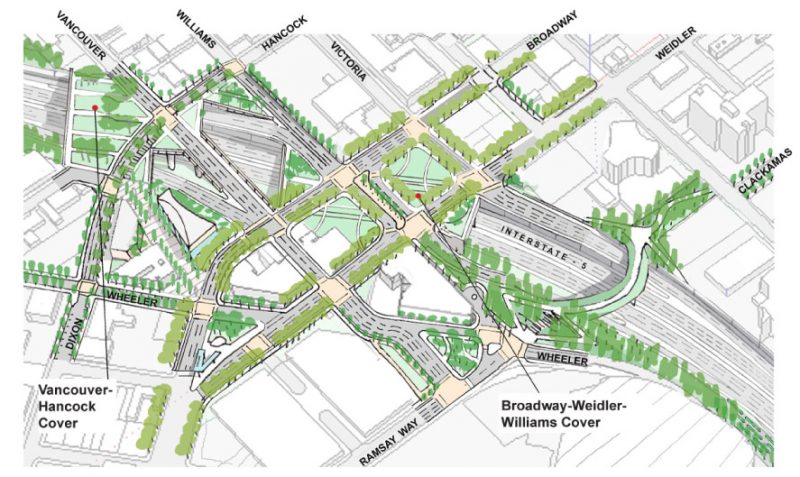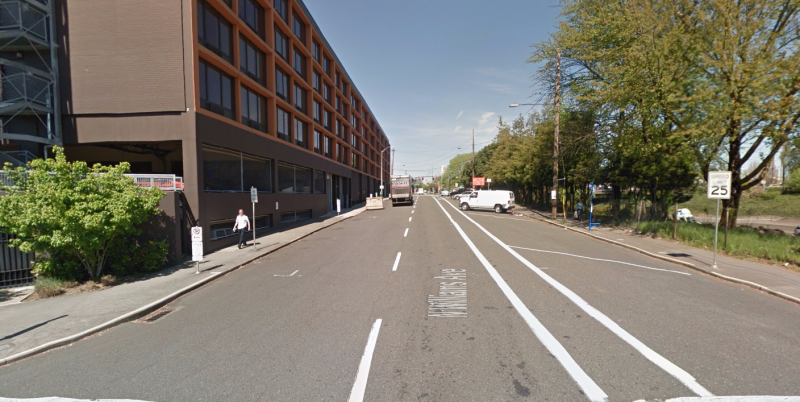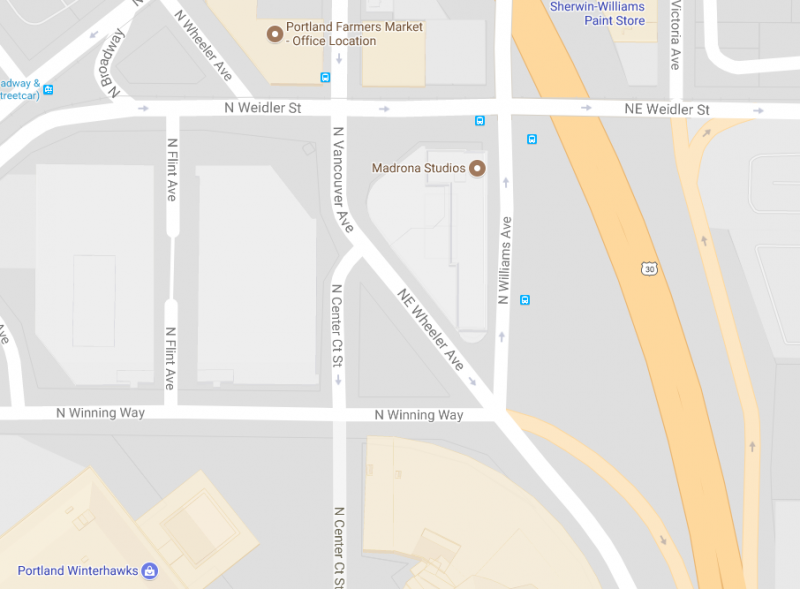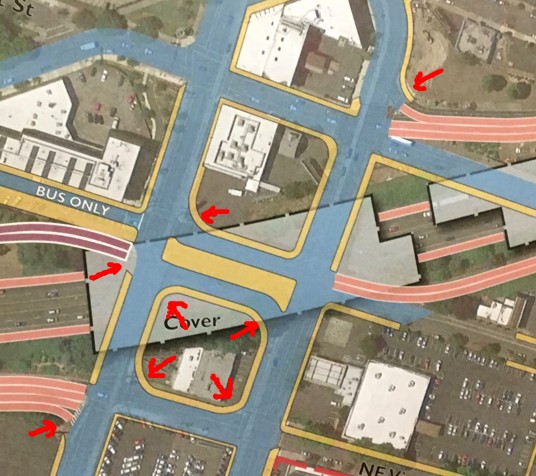
(Images: ODOT and Google Street View)
When they explain their support for spending hundreds of millions to add two new on/off freeway lanes and freeway shoulders to Interstate 5 at the Rose Quarter, Portland city leaders have a go-to answer: better surface streets.
It’s true, Mayor Ted Wheeler conceded last month, that more freeway throughput at this interchange would do “very little to arrest congestion.” Instead, more driving is likely to fill any new space that might open up on the freeway, ultimately leaving cars and trucks as jammed as before (though possibly elsewhere on the road system).
But from Portland’s perspective, Wheeler said, the $450 million Rose Quarter project is “mostly a bicycle and pedestrian play.”
OK. So we wanted to know what, exactly, are taxpayers getting in this location that would improve biking and walking?
“We think it has the potential to do a lot of great things … Improvements that the city almost certainly could not afford to do on our own.”
— Dylan Rivera, PBOT spokesman
“We think it has the potential to do a lot of great things for the central city and to reconnect neighborhoods that were disconnected by the original construction of I-5,” city transportation spokesman Dylan Rivera said in an interview last week. “Improvements that the city almost certainly could not afford to do on our own.”
We’d asked Rivera and Oregon Department of Transportation project manager Megan Channell to shine some light specifically on what would happen to all the bikeways in this area — arguably the single most important biking crossroads in the city. Four of the five intersections with the city’s highest bike counts are in the project area: Vancouver/Russell, Interstate/Lloyd/Oregon, Williams/Russell and NE Multnomah/Wheeler.
Here’s what they said the city would get.
A southbound connection to Broadway that’s closer to the Broadway Bridge
The Flint-Broadway-Wheeler intersection has been a major trouble spot for years due to Broadway’s blind-spot-enhancing curve, the number of bikes, the number of trucks, and political pressure to preserve access for everybody. The worst of this problem was mitigated in 2012 after then-Mayor Sam Adams personally backed an end to right turns onto Wheeler Avenue.
The state and city say they’ve got a new fix for this problem: redirect the thousands of bikes coming south from Vancouver Avenue each weekday off that curving stretch of Broadway.
Instead of sending people heading toward the Broadway Bridge right onto Russell just south of Legacy Emanuel Medical Center, then left onto Flint and finally right onto Broadway, the new project would instead have people stay on Vancouver for a while, then use a new right turn onto Hancock just before the crossing of I-5. (A new traffic diverter at Williams and Hancock would prevent major east-west auto traffic on the new bridge, Channell said.)
Across the freeway, Hancock would become Dixon Street:
“The new connection provides an alternate route to keep you out of the Broadway-Weidler interchange with I-5,” Channell said. From Dixon, she said, “there could be any number of connections down that would get you to Broadway.”
A new biking-walking bridge northeast of the Moda Center
This would join a gap in the grid created by the freeway by connecting Clackamas Street, east of I-5, to the street west of I-5 and just north of the Moda Center that’s currently called “Winning Way” but due to be renamed “Ramsay Way.”
Clackamas isn’t currently a major biking or walking route because it currently T-intersections into a parking garage a few blocks to the east, but if this bridge were built and that parking garage eventually redevelops — it’s owned by the same folks who recently developed Hassalo on Eighth — this Clackamas-Ramsay bridge could create a useful connection to the Moda Center area that doesn’t require going north to Broadway or downhill on Multnomah and then back uphill. It might also make the Moda Center itself, and the nearby blocks, a more attractive place to live or open a shop, which could bring more activity to this close-in neighborhood at all hours of the day.
The state and city have heard active interest about building in this area if these new connections were built and the freeway caps were to reduce traffic noise somewhat, Channell said.
“There are a number of interested developers for properties within and adjacent to those properties,” she said.
Here’s ODOT’s conceptual cross-section of a new bike-walk bridge here:
“This is also the current route for the Green Loop project, so this would solve a major crossing for the Green Loop,” said Rivera, referring to a proposed series of protected bikeways and walking investments that would join the Park Blocks, redeveloped Post Office site, Broadway Bridge, Central Eastside and Tilikum Crossing. “And like the rest of the Green Loop, this segment has not been designed, we don’t know what kind of structure it would be, etc.”
The freeway caps would allow wider sidewalks and bike lanes without the need to remove space from cars
Broadway and Weidler Street are important east-west routes for biking and could become much more important if the bike lanes on this corridor are ever upgraded downtown and/or through inner Northeast Portland. But Channell and Rivera say the bridges across I-5 (which are ODOT-controlled because they cross the freeway) create pinchpoints that prevent bike lanes and sidewalks from being widened and/or protected.
Rivera said a steel or concrete roof over the freeway between Broadway and Weidler (that is, the block to the left in the image above) would create room to shift the roadway over, making “more width for modern bike facilities.”
“The city would be looking for some sort of protection or at minimum a buffer” for the bike lane, he said.
The sidewalks, too, could be widened and better lit, Channell said. And the caps would reduce the noise and smell from I-5.
Today, she said, “as you’re biking or walking across, it feels very much like you’re crossing an interstate. The highway covers would make it feel like you’re just crossing a city block.”
A more comfortable bike route from the Rose Quarter to Williams Avenue
Channell said the southernmost block of Williams Avenue, between Wheeler Avenue and Weidler Street, would be converted to a “woonerf,” a Dutch word for a street where motor vehicles are guests, biking is welcomed and people walking have the right of way everywhere.
As you can see in the green-tinged rendering of the freeway caps above, there is some concept that the new Clackamas-Ramsay bike-walk bridge, which would land at the south end of this block, could integrate smoothly with a northbound bike route on this block.
In fact, Channell said, the only motor vehicles allowed at all would be northbound buses. (TriMet’s 4 and 44 buses currently run up this street nine times per hour in the weekday peak.)
Advertisement
Transportation advocates raise concerns
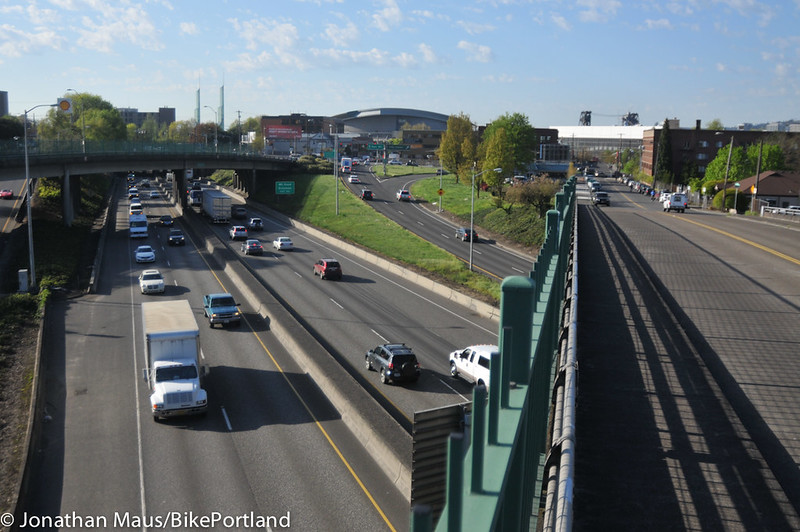
As we’ve been reporting, a coalition of advocates for better transportation, emissions reduction and social justice loudly oppose the project. Oregon Walks, the Community Cycling Center, OPAL Environmental Justice Oregon, BikeLoudPDX, anti-climate-change group 350 PDX, the Portland branch of the NAACP, the Irvington and Eliot neighborhood associations and the east Portland-based Rosewood Initiative are all among the groups that signed a letter from the No More Freeways coalition opposing this project. So have more than 400 individuals (including, I should disclose, me — see note at end of story).
City Planning Commissioner Chris Smith, a convener of the coalition, has argued that even if the investments described above (including longer, less crash-prone on- and off-ramps) are improvements, the region could find fairer and more cost-effective ways to spend $450 million.
For comparison’s sake, that sum is seven times larger than the citywide Fixing Our Streets maintenance and safety program approved by city voters last year — enough to keep that program going at its current dollar level until 2048.
Aaron Brown, a spokesman for the No More Freeways campaign, raised various concerns in an email specifically about the bikeways:
The Hancock-Dixon crossing would have a steep slope for people heading east. “Yes, it’ll be a more comfortable ride going west,” Channell confirmed, noting that most bike traffic here would be heading west on the way from Vancouver to Broadway.
The Clackamas-Ramsay bridge would be “essentially not functional for modern bike transportation planning” because of the climb required to get over a new I-5 onramp. Channell said she’s unsure of the necessary height of this bridge, but that on its east side it “will be hitting at grade with Clackamas.” “Yes, there will be a touchdown on the west side of I-5, so we’re looking at different options there to make sure it’s an easy and usable connection,” she said. “I don’t think that it would be unusable.”
“At no point in the process did the committee or engineers consider how to make service improvements on the existing infrastructure and the existing crossings.”
— Steve Bozzone, stakeholder committee member
With four-lane streets on both sides and a six-lane freeway below, the Broadway-Weidler caps “will be the most expensive, unpleasant, under utilized park spaces in the city.” Channell said the caps would probably be more important as ways to create new bikeway and walkway space than as parks. “It’s too early to say whether there’s grass, if there’s an active use there, food carts, a plaza,” added Rivera. “That’s one good question for the public.”
Doug Klotz, a co-founder of Oregon Walks and influential pedestrian design advocate who signed the No More Freeways letter, added a critique of his own in an email. According to a poster shared at a project open house last week, many of the street corners created by the project are expected to be rounded off, a design that allows easier turns for semi trucks but also encourages fast-turning cars and makes pedestrian crossings more dangerous.
Here’s the Broadway-Weidler freeway cap area, with north to the right and red arrows by Klotz:
The project’s “design phase” has barely begun, so details like those corners are the sort of thing that might change due to public pressure. But they’re an indication of how ODOT’s staff has been thinking about the project so far.
Steve Bozzone, an Oregon Walks board member and Boise neighborhood resident who served on the Rose Quarter project’s stakeholder committee in 2012 and was one of the few to vote against the project then, said in an interview this week that it was clear throughout that early process that auto movement was ODOT’s priority.
“At no point in the process did the committee or engineers consider how to make service improvements on the existing infrastructure and the existing crossings,” he said. “It was always assumed that ODOT would be allowed to bulldoze all of the bridges and we’d start from scratch. … What we never did as part of the process was look at things starting from the pedestrian perspective, saying, ‘What do we need here?’ The process hasn’t been guided by pedestrian access, pedestrian mobility. It’s been an add-on to a freeway expansion project.”
Want to speak with project staff and see the plan in person? ODOT announced this week that it’ll lead a walk and bike ride through the area at 10 a.m. on Saturday morning. Want to comment directly to ODOT? You can let them know what you think here. The comment deadline is today.
— Michael Andersen: (503) 333-7824, @andersem on Twitter and michael@portlandafoot.org
Disclosure: Last month, I signed the No More Freeway Expansions petition in my personal capacity because I don’t think any amount of public money spent to increase urban freeway travel can be morally justified. Climate change will do too much damage to our children’s lives to spend money on almost anything that further encourages urban driving. That said, I also think the public deserves a fair view of the tradeoffs, and that’s what I’ve tried to offer here.
Never miss a story. Sign-up for the daily BP Headlines email.
BikePortland needs your support.

